Assessing Multiculturalism in the Achaemenid Empire: A Research Essay
VerifiedAdded on 2023/04/23
|11
|3523
|350
Essay
AI Summary
This essay provides a comprehensive analysis of the multicultural nature of the Achaemenid Empire. It begins by introducing the empire's vast geographical extent and its significance in history, highlighting its achievements in communication and cultural integration. The essay then delves into a detailed discussion of the empire's multiculturalism, examining its linguistic diversity, artistic expressions, and religious tolerance. It explores the impact of the empire on conquered peoples, detailing how rulers adopted tolerant approaches, allowing them to retain their languages, religions, and customs. The essay also examines the empire's political and social structures, including the Satrapy system and the role of regional rulers, emphasizing the acceptance of diverse ethnic groups and their contributions to trade and transportation. Furthermore, it discusses the empire's religious policies, emphasizing the respect for various faiths and the integration of different religious beliefs. The essay concludes by arguing that the Achaemenid Empire was indeed a multicultural society that celebrated diversity and fostered a sense of unity among its diverse population, making it a significant example of cultural exchange and integration in the ancient world.

Running head: TO WHAT EXTENT THE ACHAEMENID EMPIRE IS MULTICULTURAL?
To what extent the Achaemenid Empire is multicultural?
Name of the student
Name of the university
Author Note
To what extent the Achaemenid Empire is multicultural?
Name of the student
Name of the university
Author Note
Paraphrase This Document
Need a fresh take? Get an instant paraphrase of this document with our AI Paraphraser
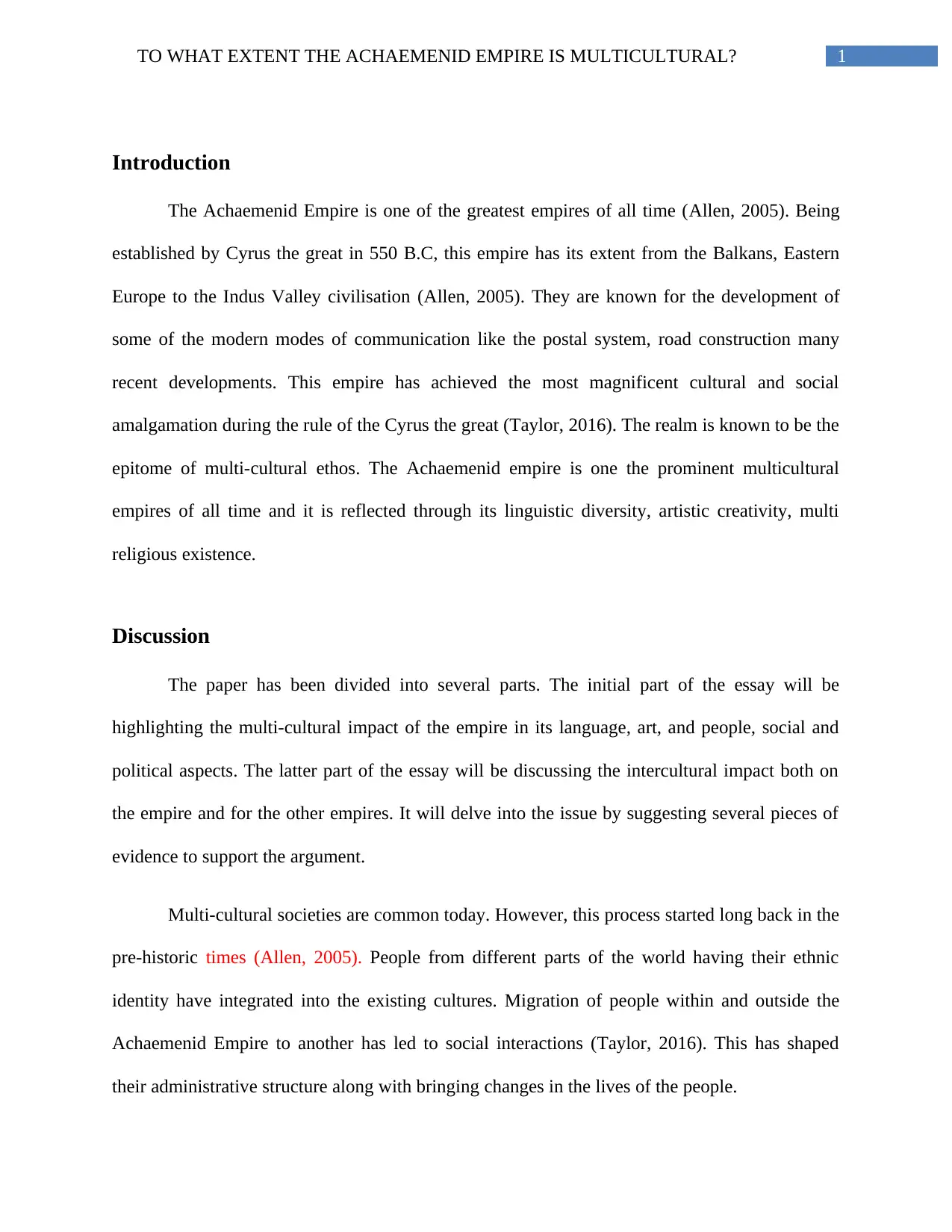
1TO WHAT EXTENT THE ACHAEMENID EMPIRE IS MULTICULTURAL?
Introduction
The Achaemenid Empire is one of the greatest empires of all time (Allen, 2005). Being
established by Cyrus the great in 550 B.C, this empire has its extent from the Balkans, Eastern
Europe to the Indus Valley civilisation (Allen, 2005). They are known for the development of
some of the modern modes of communication like the postal system, road construction many
recent developments. This empire has achieved the most magnificent cultural and social
amalgamation during the rule of the Cyrus the great (Taylor, 2016). The realm is known to be the
epitome of multi-cultural ethos. The Achaemenid empire is one the prominent multicultural
empires of all time and it is reflected through its linguistic diversity, artistic creativity, multi
religious existence.
Discussion
The paper has been divided into several parts. The initial part of the essay will be
highlighting the multi-cultural impact of the empire in its language, art, and people, social and
political aspects. The latter part of the essay will be discussing the intercultural impact both on
the empire and for the other empires. It will delve into the issue by suggesting several pieces of
evidence to support the argument.
Multi-cultural societies are common today. However, this process started long back in the
pre-historic times (Allen, 2005). People from different parts of the world having their ethnic
identity have integrated into the existing cultures. Migration of people within and outside the
Achaemenid Empire to another has led to social interactions (Taylor, 2016). This has shaped
their administrative structure along with bringing changes in the lives of the people.
Introduction
The Achaemenid Empire is one of the greatest empires of all time (Allen, 2005). Being
established by Cyrus the great in 550 B.C, this empire has its extent from the Balkans, Eastern
Europe to the Indus Valley civilisation (Allen, 2005). They are known for the development of
some of the modern modes of communication like the postal system, road construction many
recent developments. This empire has achieved the most magnificent cultural and social
amalgamation during the rule of the Cyrus the great (Taylor, 2016). The realm is known to be the
epitome of multi-cultural ethos. The Achaemenid empire is one the prominent multicultural
empires of all time and it is reflected through its linguistic diversity, artistic creativity, multi
religious existence.
Discussion
The paper has been divided into several parts. The initial part of the essay will be
highlighting the multi-cultural impact of the empire in its language, art, and people, social and
political aspects. The latter part of the essay will be discussing the intercultural impact both on
the empire and for the other empires. It will delve into the issue by suggesting several pieces of
evidence to support the argument.
Multi-cultural societies are common today. However, this process started long back in the
pre-historic times (Allen, 2005). People from different parts of the world having their ethnic
identity have integrated into the existing cultures. Migration of people within and outside the
Achaemenid Empire to another has led to social interactions (Taylor, 2016). This has shaped
their administrative structure along with bringing changes in the lives of the people.

2TO WHAT EXTENT THE ACHAEMENID EMPIRE IS MULTICULTURAL?
From the literary sources of the Greeks, who were the Persian’s greatest enemies (Allen,
2005), declares that the empire was tolerant towards other ethnic groups and it is the first empire
that has acknowledged different faith, language and most importantly the political organisations
of that time (Curtis et al., 2010). It is found that their cultural impact spilt over their
administrative structure. They are known to have adopted the indigenous language of the kinds
they conquered (Taylor, 2016). They even used the “hieroglyphic” script of the Egyptians
(Taylor, 2016). From the account of Alexander the great, it is known that he was impressed by
the system of absorption and amalgamation of the different cultures and religions even though he
destructed some of them after conquering the empire and their land (Blair, 2016). The prime
characteristics of the Persian art are the “eclectic” form, a mixture of the Median, Assyrian and
the Greek style (Waters, 2004). Their ceremonial capital, the Persepolis is an example of this
probable source where historians have found artifacts depicting multi-cultural presence. It is not
a representation of the political supremacy of the empire instead an example of social and
cultural interactions across kingdoms (Waters, 2004).
Art and multiculturalism
The first Persian Empire under Cyrus the great mostly followed one dominant religion
(Blair, 2016) Zoroastrianism, even though they followed a monotheistic religion; the art and
language of the empire were syncretisms by developing a unique Persian style of art (Waters,
2004). Materials like gold and silver are primarily drawn from the empires living nearby and the
empire followed multi-lingual inscriptions which provide enough evidence of multi-cultural
presence at that time (Blair, 2016). Most importantly, the metalwork involved techniques used by
the Medes. Persian art is known to have adopted the local artists as well the language of the
conquered people (Bourke, 2008). One of the most prominent examples of the high relief used
From the literary sources of the Greeks, who were the Persian’s greatest enemies (Allen,
2005), declares that the empire was tolerant towards other ethnic groups and it is the first empire
that has acknowledged different faith, language and most importantly the political organisations
of that time (Curtis et al., 2010). It is found that their cultural impact spilt over their
administrative structure. They are known to have adopted the indigenous language of the kinds
they conquered (Taylor, 2016). They even used the “hieroglyphic” script of the Egyptians
(Taylor, 2016). From the account of Alexander the great, it is known that he was impressed by
the system of absorption and amalgamation of the different cultures and religions even though he
destructed some of them after conquering the empire and their land (Blair, 2016). The prime
characteristics of the Persian art are the “eclectic” form, a mixture of the Median, Assyrian and
the Greek style (Waters, 2004). Their ceremonial capital, the Persepolis is an example of this
probable source where historians have found artifacts depicting multi-cultural presence. It is not
a representation of the political supremacy of the empire instead an example of social and
cultural interactions across kingdoms (Waters, 2004).
Art and multiculturalism
The first Persian Empire under Cyrus the great mostly followed one dominant religion
(Blair, 2016) Zoroastrianism, even though they followed a monotheistic religion; the art and
language of the empire were syncretisms by developing a unique Persian style of art (Waters,
2004). Materials like gold and silver are primarily drawn from the empires living nearby and the
empire followed multi-lingual inscriptions which provide enough evidence of multi-cultural
presence at that time (Blair, 2016). Most importantly, the metalwork involved techniques used by
the Medes. Persian art is known to have adopted the local artists as well the language of the
conquered people (Bourke, 2008). One of the most prominent examples of the high relief used
⊘ This is a preview!⊘
Do you want full access?
Subscribe today to unlock all pages.

Trusted by 1+ million students worldwide
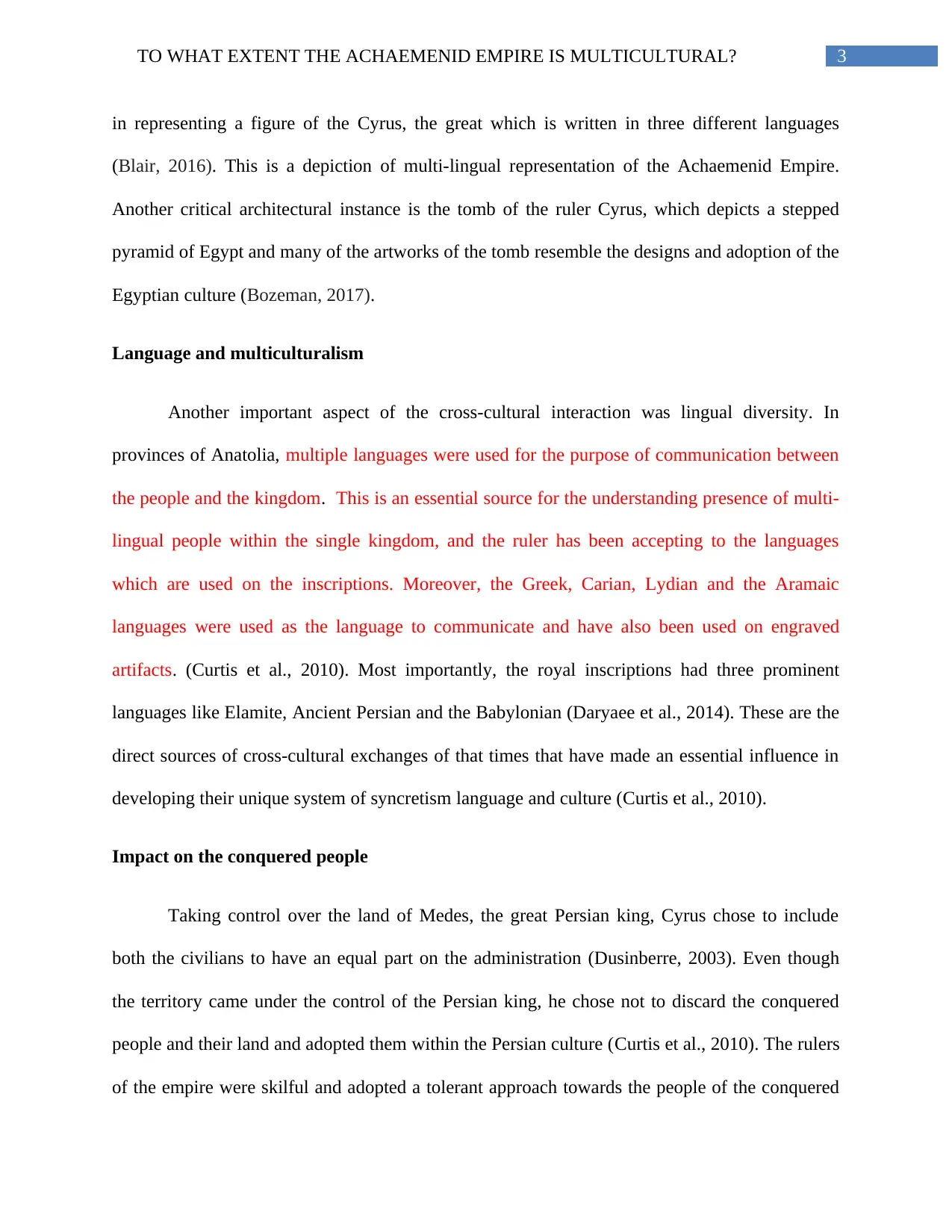
3TO WHAT EXTENT THE ACHAEMENID EMPIRE IS MULTICULTURAL?
in representing a figure of the Cyrus, the great which is written in three different languages
(Blair, 2016). This is a depiction of multi-lingual representation of the Achaemenid Empire.
Another critical architectural instance is the tomb of the ruler Cyrus, which depicts a stepped
pyramid of Egypt and many of the artworks of the tomb resemble the designs and adoption of the
Egyptian culture (Bozeman, 2017).
Language and multiculturalism
Another important aspect of the cross-cultural interaction was lingual diversity. In
provinces of Anatolia, multiple languages were used for the purpose of communication between
the people and the kingdom. This is an essential source for the understanding presence of multi-
lingual people within the single kingdom, and the ruler has been accepting to the languages
which are used on the inscriptions. Moreover, the Greek, Carian, Lydian and the Aramaic
languages were used as the language to communicate and have also been used on engraved
artifacts. (Curtis et al., 2010). Most importantly, the royal inscriptions had three prominent
languages like Elamite, Ancient Persian and the Babylonian (Daryaee et al., 2014). These are the
direct sources of cross-cultural exchanges of that times that have made an essential influence in
developing their unique system of syncretism language and culture (Curtis et al., 2010).
Impact on the conquered people
Taking control over the land of Medes, the great Persian king, Cyrus chose to include
both the civilians to have an equal part on the administration (Dusinberre, 2003). Even though
the territory came under the control of the Persian king, he chose not to discard the conquered
people and their land and adopted them within the Persian culture (Curtis et al., 2010). The rulers
of the empire were skilful and adopted a tolerant approach towards the people of the conquered
in representing a figure of the Cyrus, the great which is written in three different languages
(Blair, 2016). This is a depiction of multi-lingual representation of the Achaemenid Empire.
Another critical architectural instance is the tomb of the ruler Cyrus, which depicts a stepped
pyramid of Egypt and many of the artworks of the tomb resemble the designs and adoption of the
Egyptian culture (Bozeman, 2017).
Language and multiculturalism
Another important aspect of the cross-cultural interaction was lingual diversity. In
provinces of Anatolia, multiple languages were used for the purpose of communication between
the people and the kingdom. This is an essential source for the understanding presence of multi-
lingual people within the single kingdom, and the ruler has been accepting to the languages
which are used on the inscriptions. Moreover, the Greek, Carian, Lydian and the Aramaic
languages were used as the language to communicate and have also been used on engraved
artifacts. (Curtis et al., 2010). Most importantly, the royal inscriptions had three prominent
languages like Elamite, Ancient Persian and the Babylonian (Daryaee et al., 2014). These are the
direct sources of cross-cultural exchanges of that times that have made an essential influence in
developing their unique system of syncretism language and culture (Curtis et al., 2010).
Impact on the conquered people
Taking control over the land of Medes, the great Persian king, Cyrus chose to include
both the civilians to have an equal part on the administration (Dusinberre, 2003). Even though
the territory came under the control of the Persian king, he chose not to discard the conquered
people and their land and adopted them within the Persian culture (Curtis et al., 2010). The rulers
of the empire were skilful and adopted a tolerant approach towards the people of the conquered
Paraphrase This Document
Need a fresh take? Get an instant paraphrase of this document with our AI Paraphraser
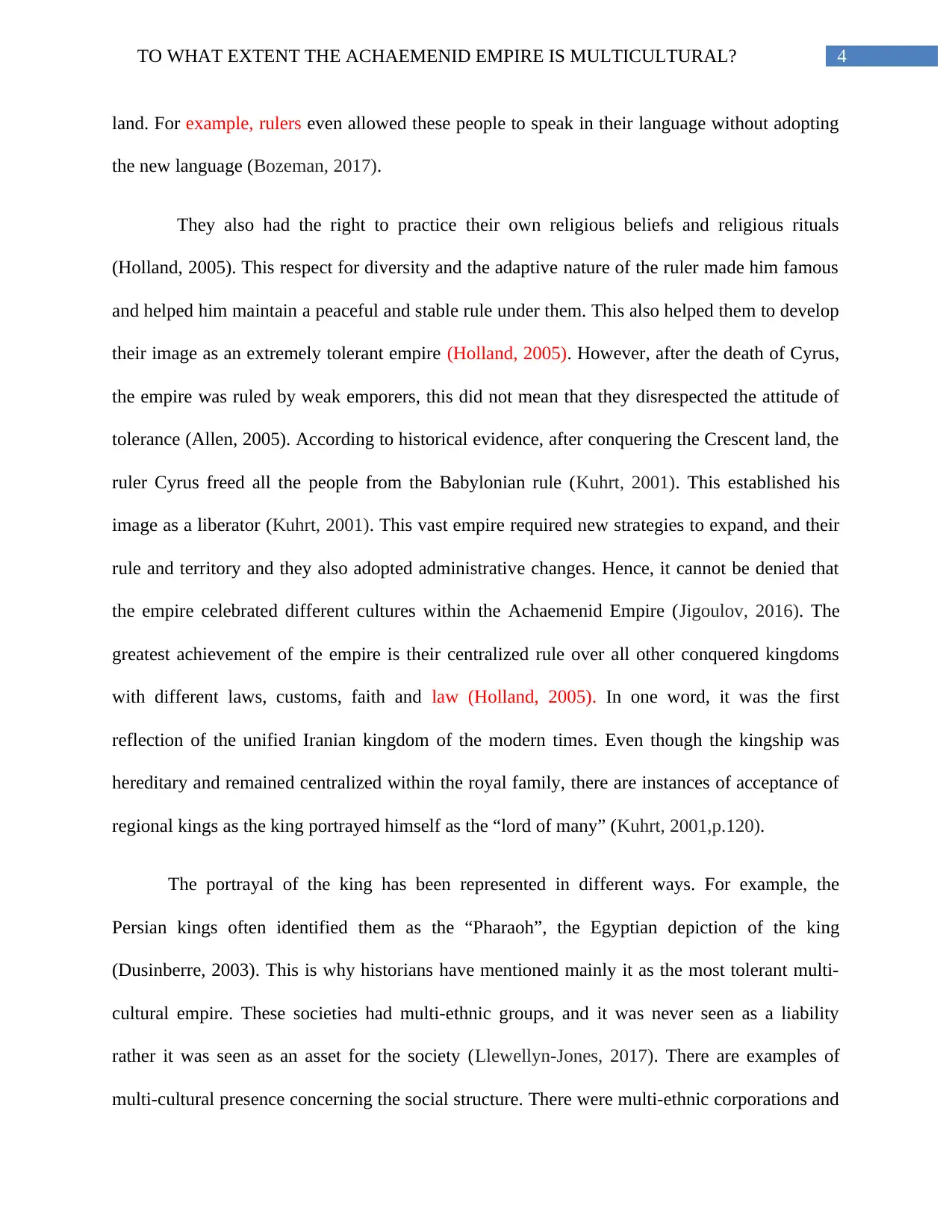
4TO WHAT EXTENT THE ACHAEMENID EMPIRE IS MULTICULTURAL?
land. For example, rulers even allowed these people to speak in their language without adopting
the new language (Bozeman, 2017).
They also had the right to practice their own religious beliefs and religious rituals
(Holland, 2005). This respect for diversity and the adaptive nature of the ruler made him famous
and helped him maintain a peaceful and stable rule under them. This also helped them to develop
their image as an extremely tolerant empire (Holland, 2005). However, after the death of Cyrus,
the empire was ruled by weak emporers, this did not mean that they disrespected the attitude of
tolerance (Allen, 2005). According to historical evidence, after conquering the Crescent land, the
ruler Cyrus freed all the people from the Babylonian rule (Kuhrt, 2001). This established his
image as a liberator (Kuhrt, 2001). This vast empire required new strategies to expand, and their
rule and territory and they also adopted administrative changes. Hence, it cannot be denied that
the empire celebrated different cultures within the Achaemenid Empire (Jigoulov, 2016). The
greatest achievement of the empire is their centralized rule over all other conquered kingdoms
with different laws, customs, faith and law (Holland, 2005). In one word, it was the first
reflection of the unified Iranian kingdom of the modern times. Even though the kingship was
hereditary and remained centralized within the royal family, there are instances of acceptance of
regional kings as the king portrayed himself as the “lord of many” (Kuhrt, 2001,p.120).
The portrayal of the king has been represented in different ways. For example, the
Persian kings often identified them as the “Pharaoh”, the Egyptian depiction of the king
(Dusinberre, 2003). This is why historians have mentioned mainly it as the most tolerant multi-
cultural empire. These societies had multi-ethnic groups, and it was never seen as a liability
rather it was seen as an asset for the society (Llewellyn-Jones, 2017). There are examples of
multi-cultural presence concerning the social structure. There were multi-ethnic corporations and
land. For example, rulers even allowed these people to speak in their language without adopting
the new language (Bozeman, 2017).
They also had the right to practice their own religious beliefs and religious rituals
(Holland, 2005). This respect for diversity and the adaptive nature of the ruler made him famous
and helped him maintain a peaceful and stable rule under them. This also helped them to develop
their image as an extremely tolerant empire (Holland, 2005). However, after the death of Cyrus,
the empire was ruled by weak emporers, this did not mean that they disrespected the attitude of
tolerance (Allen, 2005). According to historical evidence, after conquering the Crescent land, the
ruler Cyrus freed all the people from the Babylonian rule (Kuhrt, 2001). This established his
image as a liberator (Kuhrt, 2001). This vast empire required new strategies to expand, and their
rule and territory and they also adopted administrative changes. Hence, it cannot be denied that
the empire celebrated different cultures within the Achaemenid Empire (Jigoulov, 2016). The
greatest achievement of the empire is their centralized rule over all other conquered kingdoms
with different laws, customs, faith and law (Holland, 2005). In one word, it was the first
reflection of the unified Iranian kingdom of the modern times. Even though the kingship was
hereditary and remained centralized within the royal family, there are instances of acceptance of
regional kings as the king portrayed himself as the “lord of many” (Kuhrt, 2001,p.120).
The portrayal of the king has been represented in different ways. For example, the
Persian kings often identified them as the “Pharaoh”, the Egyptian depiction of the king
(Dusinberre, 2003). This is why historians have mentioned mainly it as the most tolerant multi-
cultural empire. These societies had multi-ethnic groups, and it was never seen as a liability
rather it was seen as an asset for the society (Llewellyn-Jones, 2017). There are examples of
multi-cultural presence concerning the social structure. There were multi-ethnic corporations and
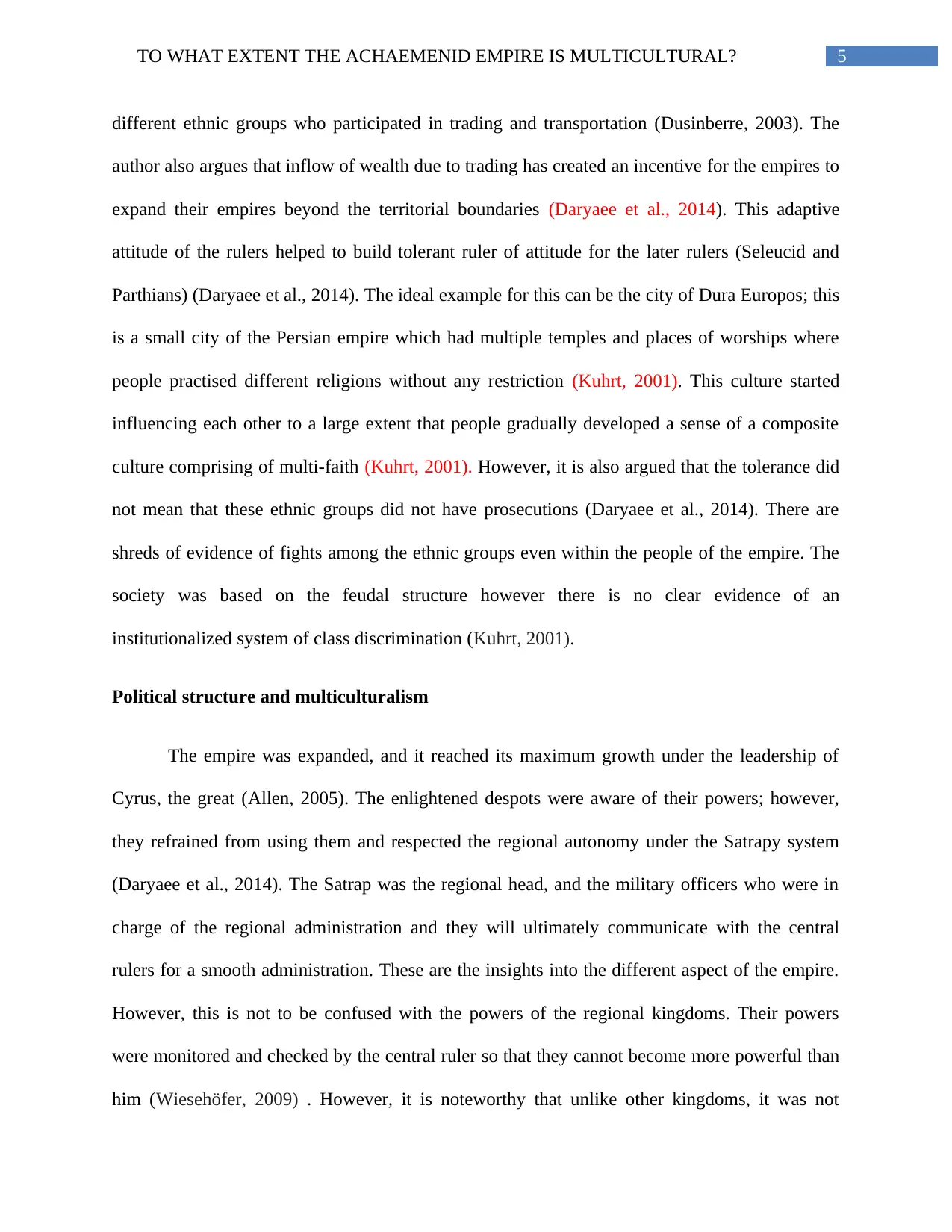
5TO WHAT EXTENT THE ACHAEMENID EMPIRE IS MULTICULTURAL?
different ethnic groups who participated in trading and transportation (Dusinberre, 2003). The
author also argues that inflow of wealth due to trading has created an incentive for the empires to
expand their empires beyond the territorial boundaries (Daryaee et al., 2014). This adaptive
attitude of the rulers helped to build tolerant ruler of attitude for the later rulers (Seleucid and
Parthians) (Daryaee et al., 2014). The ideal example for this can be the city of Dura Europos; this
is a small city of the Persian empire which had multiple temples and places of worships where
people practised different religions without any restriction (Kuhrt, 2001). This culture started
influencing each other to a large extent that people gradually developed a sense of a composite
culture comprising of multi-faith (Kuhrt, 2001). However, it is also argued that the tolerance did
not mean that these ethnic groups did not have prosecutions (Daryaee et al., 2014). There are
shreds of evidence of fights among the ethnic groups even within the people of the empire. The
society was based on the feudal structure however there is no clear evidence of an
institutionalized system of class discrimination (Kuhrt, 2001).
Political structure and multiculturalism
The empire was expanded, and it reached its maximum growth under the leadership of
Cyrus, the great (Allen, 2005). The enlightened despots were aware of their powers; however,
they refrained from using them and respected the regional autonomy under the Satrapy system
(Daryaee et al., 2014). The Satrap was the regional head, and the military officers who were in
charge of the regional administration and they will ultimately communicate with the central
rulers for a smooth administration. These are the insights into the different aspect of the empire.
However, this is not to be confused with the powers of the regional kingdoms. Their powers
were monitored and checked by the central ruler so that they cannot become more powerful than
him (Wiesehöfer, 2009) . However, it is noteworthy that unlike other kingdoms, it was not
different ethnic groups who participated in trading and transportation (Dusinberre, 2003). The
author also argues that inflow of wealth due to trading has created an incentive for the empires to
expand their empires beyond the territorial boundaries (Daryaee et al., 2014). This adaptive
attitude of the rulers helped to build tolerant ruler of attitude for the later rulers (Seleucid and
Parthians) (Daryaee et al., 2014). The ideal example for this can be the city of Dura Europos; this
is a small city of the Persian empire which had multiple temples and places of worships where
people practised different religions without any restriction (Kuhrt, 2001). This culture started
influencing each other to a large extent that people gradually developed a sense of a composite
culture comprising of multi-faith (Kuhrt, 2001). However, it is also argued that the tolerance did
not mean that these ethnic groups did not have prosecutions (Daryaee et al., 2014). There are
shreds of evidence of fights among the ethnic groups even within the people of the empire. The
society was based on the feudal structure however there is no clear evidence of an
institutionalized system of class discrimination (Kuhrt, 2001).
Political structure and multiculturalism
The empire was expanded, and it reached its maximum growth under the leadership of
Cyrus, the great (Allen, 2005). The enlightened despots were aware of their powers; however,
they refrained from using them and respected the regional autonomy under the Satrapy system
(Daryaee et al., 2014). The Satrap was the regional head, and the military officers who were in
charge of the regional administration and they will ultimately communicate with the central
rulers for a smooth administration. These are the insights into the different aspect of the empire.
However, this is not to be confused with the powers of the regional kingdoms. Their powers
were monitored and checked by the central ruler so that they cannot become more powerful than
him (Wiesehöfer, 2009) . However, it is noteworthy that unlike other kingdoms, it was not
⊘ This is a preview!⊘
Do you want full access?
Subscribe today to unlock all pages.

Trusted by 1+ million students worldwide
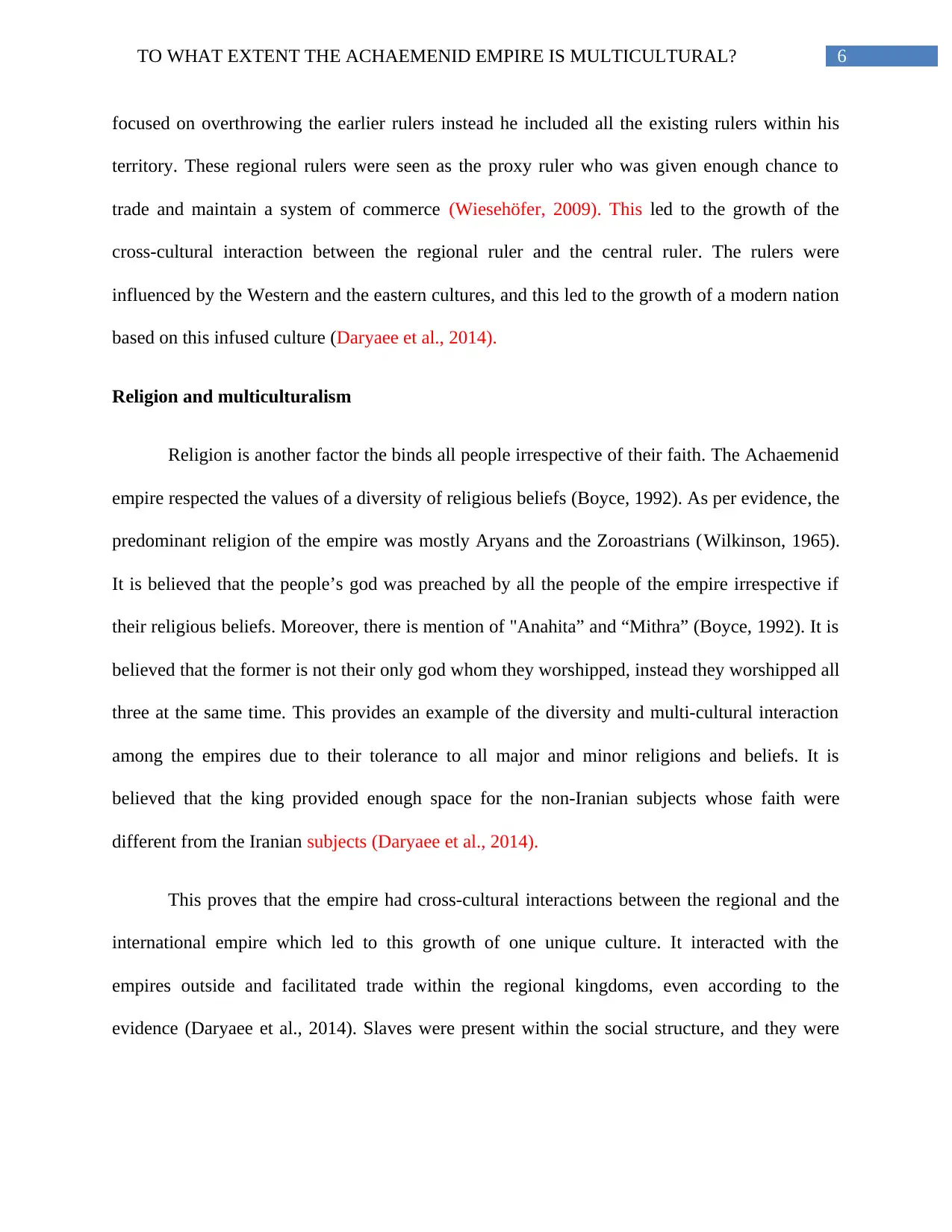
6TO WHAT EXTENT THE ACHAEMENID EMPIRE IS MULTICULTURAL?
focused on overthrowing the earlier rulers instead he included all the existing rulers within his
territory. These regional rulers were seen as the proxy ruler who was given enough chance to
trade and maintain a system of commerce (Wiesehöfer, 2009). This led to the growth of the
cross-cultural interaction between the regional ruler and the central ruler. The rulers were
influenced by the Western and the eastern cultures, and this led to the growth of a modern nation
based on this infused culture (Daryaee et al., 2014).
Religion and multiculturalism
Religion is another factor the binds all people irrespective of their faith. The Achaemenid
empire respected the values of a diversity of religious beliefs (Boyce, 1992). As per evidence, the
predominant religion of the empire was mostly Aryans and the Zoroastrians (Wilkinson, 1965).
It is believed that the people’s god was preached by all the people of the empire irrespective if
their religious beliefs. Moreover, there is mention of "Anahita” and “Mithra” (Boyce, 1992). It is
believed that the former is not their only god whom they worshipped, instead they worshipped all
three at the same time. This provides an example of the diversity and multi-cultural interaction
among the empires due to their tolerance to all major and minor religions and beliefs. It is
believed that the king provided enough space for the non-Iranian subjects whose faith were
different from the Iranian subjects (Daryaee et al., 2014).
This proves that the empire had cross-cultural interactions between the regional and the
international empire which led to this growth of one unique culture. It interacted with the
empires outside and facilitated trade within the regional kingdoms, even according to the
evidence (Daryaee et al., 2014). Slaves were present within the social structure, and they were
focused on overthrowing the earlier rulers instead he included all the existing rulers within his
territory. These regional rulers were seen as the proxy ruler who was given enough chance to
trade and maintain a system of commerce (Wiesehöfer, 2009). This led to the growth of the
cross-cultural interaction between the regional ruler and the central ruler. The rulers were
influenced by the Western and the eastern cultures, and this led to the growth of a modern nation
based on this infused culture (Daryaee et al., 2014).
Religion and multiculturalism
Religion is another factor the binds all people irrespective of their faith. The Achaemenid
empire respected the values of a diversity of religious beliefs (Boyce, 1992). As per evidence, the
predominant religion of the empire was mostly Aryans and the Zoroastrians (Wilkinson, 1965).
It is believed that the people’s god was preached by all the people of the empire irrespective if
their religious beliefs. Moreover, there is mention of "Anahita” and “Mithra” (Boyce, 1992). It is
believed that the former is not their only god whom they worshipped, instead they worshipped all
three at the same time. This provides an example of the diversity and multi-cultural interaction
among the empires due to their tolerance to all major and minor religions and beliefs. It is
believed that the king provided enough space for the non-Iranian subjects whose faith were
different from the Iranian subjects (Daryaee et al., 2014).
This proves that the empire had cross-cultural interactions between the regional and the
international empire which led to this growth of one unique culture. It interacted with the
empires outside and facilitated trade within the regional kingdoms, even according to the
evidence (Daryaee et al., 2014). Slaves were present within the social structure, and they were
Paraphrase This Document
Need a fresh take? Get an instant paraphrase of this document with our AI Paraphraser
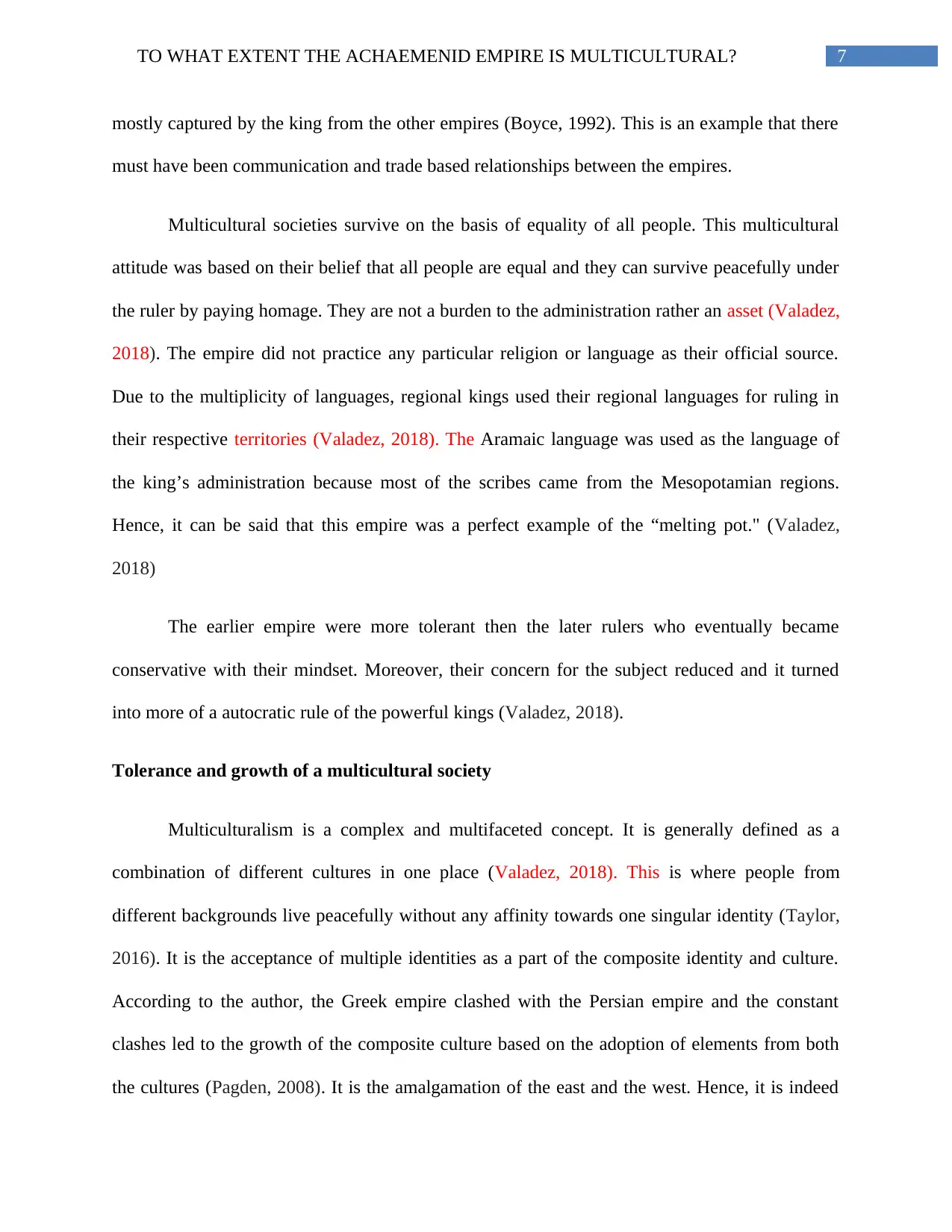
7TO WHAT EXTENT THE ACHAEMENID EMPIRE IS MULTICULTURAL?
mostly captured by the king from the other empires (Boyce, 1992). This is an example that there
must have been communication and trade based relationships between the empires.
Multicultural societies survive on the basis of equality of all people. This multicultural
attitude was based on their belief that all people are equal and they can survive peacefully under
the ruler by paying homage. They are not a burden to the administration rather an asset (Valadez,
2018). The empire did not practice any particular religion or language as their official source.
Due to the multiplicity of languages, regional kings used their regional languages for ruling in
their respective territories (Valadez, 2018). The Aramaic language was used as the language of
the king’s administration because most of the scribes came from the Mesopotamian regions.
Hence, it can be said that this empire was a perfect example of the “melting pot." (Valadez,
2018)
The earlier empire were more tolerant then the later rulers who eventually became
conservative with their mindset. Moreover, their concern for the subject reduced and it turned
into more of a autocratic rule of the powerful kings (Valadez, 2018).
Tolerance and growth of a multicultural society
Multiculturalism is a complex and multifaceted concept. It is generally defined as a
combination of different cultures in one place (Valadez, 2018). This is where people from
different backgrounds live peacefully without any affinity towards one singular identity (Taylor,
2016). It is the acceptance of multiple identities as a part of the composite identity and culture.
According to the author, the Greek empire clashed with the Persian empire and the constant
clashes led to the growth of the composite culture based on the adoption of elements from both
the cultures (Pagden, 2008). It is the amalgamation of the east and the west. Hence, it is indeed
mostly captured by the king from the other empires (Boyce, 1992). This is an example that there
must have been communication and trade based relationships between the empires.
Multicultural societies survive on the basis of equality of all people. This multicultural
attitude was based on their belief that all people are equal and they can survive peacefully under
the ruler by paying homage. They are not a burden to the administration rather an asset (Valadez,
2018). The empire did not practice any particular religion or language as their official source.
Due to the multiplicity of languages, regional kings used their regional languages for ruling in
their respective territories (Valadez, 2018). The Aramaic language was used as the language of
the king’s administration because most of the scribes came from the Mesopotamian regions.
Hence, it can be said that this empire was a perfect example of the “melting pot." (Valadez,
2018)
The earlier empire were more tolerant then the later rulers who eventually became
conservative with their mindset. Moreover, their concern for the subject reduced and it turned
into more of a autocratic rule of the powerful kings (Valadez, 2018).
Tolerance and growth of a multicultural society
Multiculturalism is a complex and multifaceted concept. It is generally defined as a
combination of different cultures in one place (Valadez, 2018). This is where people from
different backgrounds live peacefully without any affinity towards one singular identity (Taylor,
2016). It is the acceptance of multiple identities as a part of the composite identity and culture.
According to the author, the Greek empire clashed with the Persian empire and the constant
clashes led to the growth of the composite culture based on the adoption of elements from both
the cultures (Pagden, 2008). It is the amalgamation of the east and the west. Hence, it is indeed
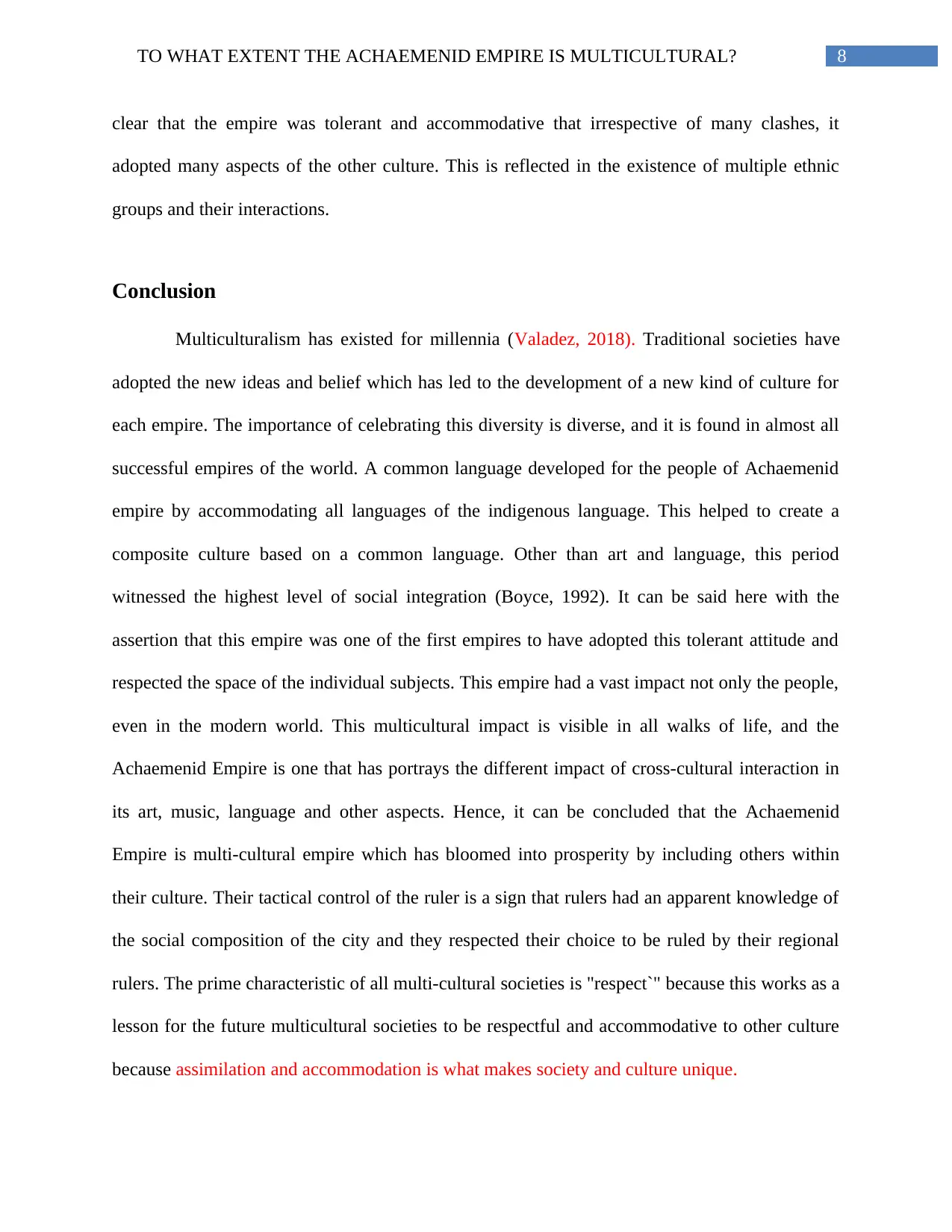
8TO WHAT EXTENT THE ACHAEMENID EMPIRE IS MULTICULTURAL?
clear that the empire was tolerant and accommodative that irrespective of many clashes, it
adopted many aspects of the other culture. This is reflected in the existence of multiple ethnic
groups and their interactions.
Conclusion
Multiculturalism has existed for millennia (Valadez, 2018). Traditional societies have
adopted the new ideas and belief which has led to the development of a new kind of culture for
each empire. The importance of celebrating this diversity is diverse, and it is found in almost all
successful empires of the world. A common language developed for the people of Achaemenid
empire by accommodating all languages of the indigenous language. This helped to create a
composite culture based on a common language. Other than art and language, this period
witnessed the highest level of social integration (Boyce, 1992). It can be said here with the
assertion that this empire was one of the first empires to have adopted this tolerant attitude and
respected the space of the individual subjects. This empire had a vast impact not only the people,
even in the modern world. This multicultural impact is visible in all walks of life, and the
Achaemenid Empire is one that has portrays the different impact of cross-cultural interaction in
its art, music, language and other aspects. Hence, it can be concluded that the Achaemenid
Empire is multi-cultural empire which has bloomed into prosperity by including others within
their culture. Their tactical control of the ruler is a sign that rulers had an apparent knowledge of
the social composition of the city and they respected their choice to be ruled by their regional
rulers. The prime characteristic of all multi-cultural societies is "respect`" because this works as a
lesson for the future multicultural societies to be respectful and accommodative to other culture
because assimilation and accommodation is what makes society and culture unique.
clear that the empire was tolerant and accommodative that irrespective of many clashes, it
adopted many aspects of the other culture. This is reflected in the existence of multiple ethnic
groups and their interactions.
Conclusion
Multiculturalism has existed for millennia (Valadez, 2018). Traditional societies have
adopted the new ideas and belief which has led to the development of a new kind of culture for
each empire. The importance of celebrating this diversity is diverse, and it is found in almost all
successful empires of the world. A common language developed for the people of Achaemenid
empire by accommodating all languages of the indigenous language. This helped to create a
composite culture based on a common language. Other than art and language, this period
witnessed the highest level of social integration (Boyce, 1992). It can be said here with the
assertion that this empire was one of the first empires to have adopted this tolerant attitude and
respected the space of the individual subjects. This empire had a vast impact not only the people,
even in the modern world. This multicultural impact is visible in all walks of life, and the
Achaemenid Empire is one that has portrays the different impact of cross-cultural interaction in
its art, music, language and other aspects. Hence, it can be concluded that the Achaemenid
Empire is multi-cultural empire which has bloomed into prosperity by including others within
their culture. Their tactical control of the ruler is a sign that rulers had an apparent knowledge of
the social composition of the city and they respected their choice to be ruled by their regional
rulers. The prime characteristic of all multi-cultural societies is "respect`" because this works as a
lesson for the future multicultural societies to be respectful and accommodative to other culture
because assimilation and accommodation is what makes society and culture unique.
⊘ This is a preview!⊘
Do you want full access?
Subscribe today to unlock all pages.

Trusted by 1+ million students worldwide
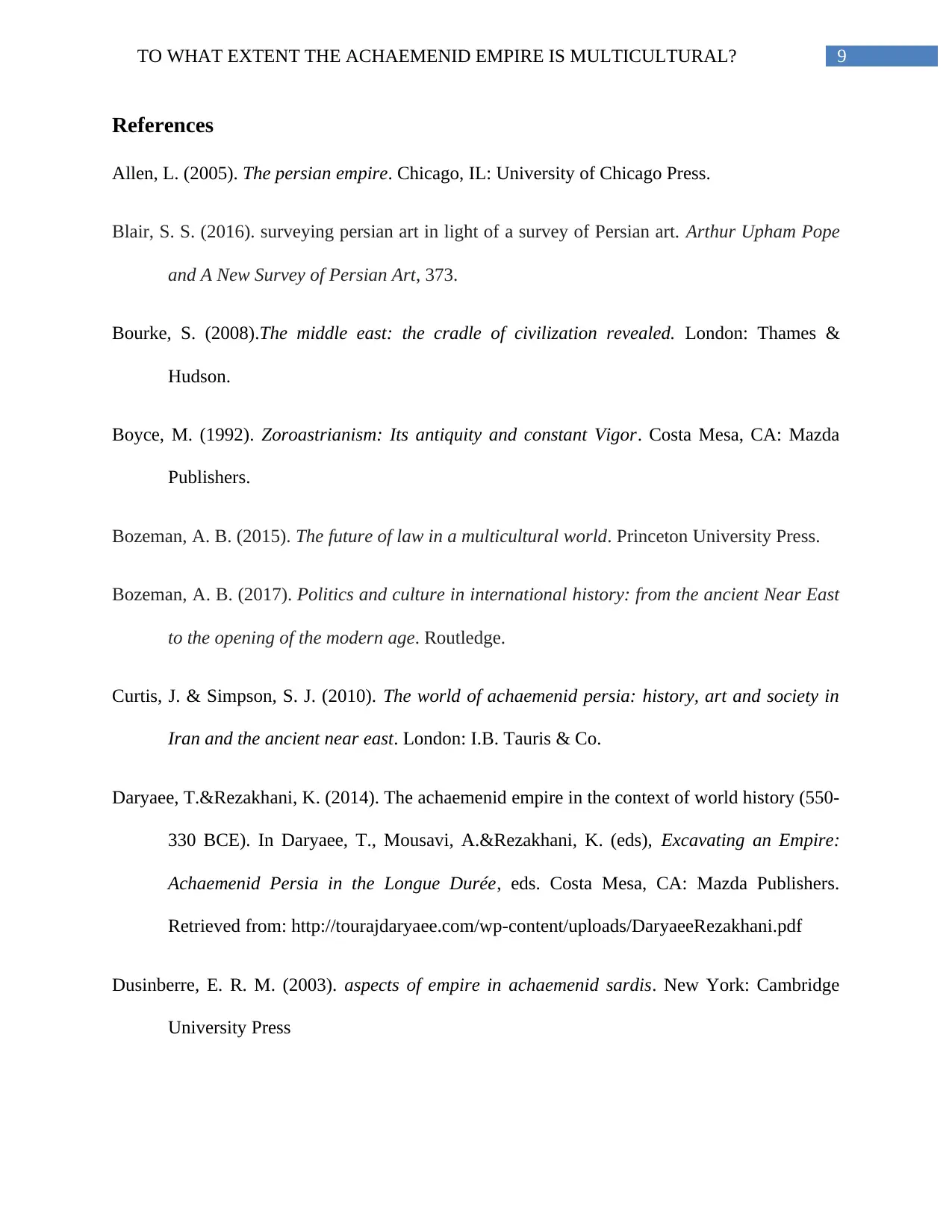
9TO WHAT EXTENT THE ACHAEMENID EMPIRE IS MULTICULTURAL?
References
Allen, L. (2005). The persian empire. Chicago, IL: University of Chicago Press.
Blair, S. S. (2016). surveying persian art in light of a survey of Persian art. Arthur Upham Pope
and A New Survey of Persian Art, 373.
Bourke, S. (2008).The middle east: the cradle of civilization revealed. London: Thames &
Hudson.
Boyce, M. (1992). Zoroastrianism: Its antiquity and constant Vigor. Costa Mesa, CA: Mazda
Publishers.
Bozeman, A. B. (2015). The future of law in a multicultural world. Princeton University Press.
Bozeman, A. B. (2017). Politics and culture in international history: from the ancient Near East
to the opening of the modern age. Routledge.
Curtis, J. & Simpson, S. J. (2010). The world of achaemenid persia: history, art and society in
Iran and the ancient near east. London: I.B. Tauris & Co.
Daryaee, T.&Rezakhani, K. (2014). The achaemenid empire in the context of world history (550-
330 BCE). In Daryaee, T., Mousavi, A.&Rezakhani, K. (eds), Excavating an Empire:
Achaemenid Persia in the Longue Durée, eds. Costa Mesa, CA: Mazda Publishers.
Retrieved from: http://tourajdaryaee.com/wp-content/uploads/DaryaeeRezakhani.pdf
Dusinberre, E. R. M. (2003). aspects of empire in achaemenid sardis. New York: Cambridge
University Press
References
Allen, L. (2005). The persian empire. Chicago, IL: University of Chicago Press.
Blair, S. S. (2016). surveying persian art in light of a survey of Persian art. Arthur Upham Pope
and A New Survey of Persian Art, 373.
Bourke, S. (2008).The middle east: the cradle of civilization revealed. London: Thames &
Hudson.
Boyce, M. (1992). Zoroastrianism: Its antiquity and constant Vigor. Costa Mesa, CA: Mazda
Publishers.
Bozeman, A. B. (2015). The future of law in a multicultural world. Princeton University Press.
Bozeman, A. B. (2017). Politics and culture in international history: from the ancient Near East
to the opening of the modern age. Routledge.
Curtis, J. & Simpson, S. J. (2010). The world of achaemenid persia: history, art and society in
Iran and the ancient near east. London: I.B. Tauris & Co.
Daryaee, T.&Rezakhani, K. (2014). The achaemenid empire in the context of world history (550-
330 BCE). In Daryaee, T., Mousavi, A.&Rezakhani, K. (eds), Excavating an Empire:
Achaemenid Persia in the Longue Durée, eds. Costa Mesa, CA: Mazda Publishers.
Retrieved from: http://tourajdaryaee.com/wp-content/uploads/DaryaeeRezakhani.pdf
Dusinberre, E. R. M. (2003). aspects of empire in achaemenid sardis. New York: Cambridge
University Press
Paraphrase This Document
Need a fresh take? Get an instant paraphrase of this document with our AI Paraphraser
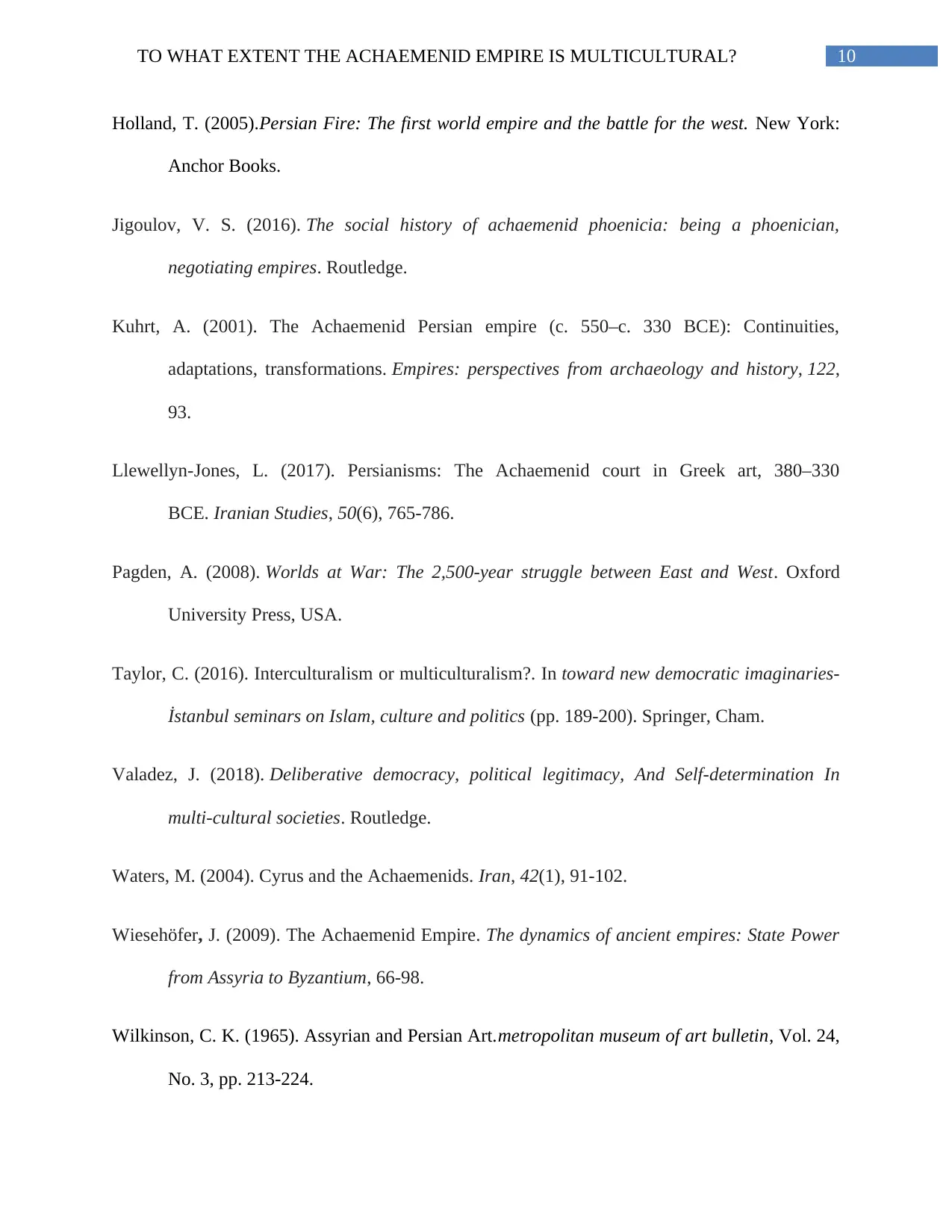
10TO WHAT EXTENT THE ACHAEMENID EMPIRE IS MULTICULTURAL?
Holland, T. (2005).Persian Fire: The first world empire and the battle for the west. New York:
Anchor Books.
Jigoulov, V. S. (2016). The social history of achaemenid phoenicia: being a phoenician,
negotiating empires. Routledge.
Kuhrt, A. (2001). The Achaemenid Persian empire (c. 550–c. 330 BCE): Continuities,
adaptations, transformations. Empires: perspectives from archaeology and history, 122,
93.
Llewellyn-Jones, L. (2017). Persianisms: The Achaemenid court in Greek art, 380–330
BCE. Iranian Studies, 50(6), 765-786.
Pagden, A. (2008). Worlds at War: The 2,500-year struggle between East and West. Oxford
University Press, USA.
Taylor, C. (2016). Interculturalism or multiculturalism?. In toward new democratic imaginaries-
İstanbul seminars on Islam, culture and politics (pp. 189-200). Springer, Cham.
Valadez, J. (2018). Deliberative democracy, political legitimacy, And Self-determination In
multi-cultural societies. Routledge.
Waters, M. (2004). Cyrus and the Achaemenids. Iran, 42(1), 91-102.
Wiesehöfer, J. (2009). The Achaemenid Empire. The dynamics of ancient empires: State Power
from Assyria to Byzantium, 66-98.
Wilkinson, C. K. (1965). Assyrian and Persian Art.metropolitan museum of art bulletin, Vol. 24,
No. 3, pp. 213-224.
Holland, T. (2005).Persian Fire: The first world empire and the battle for the west. New York:
Anchor Books.
Jigoulov, V. S. (2016). The social history of achaemenid phoenicia: being a phoenician,
negotiating empires. Routledge.
Kuhrt, A. (2001). The Achaemenid Persian empire (c. 550–c. 330 BCE): Continuities,
adaptations, transformations. Empires: perspectives from archaeology and history, 122,
93.
Llewellyn-Jones, L. (2017). Persianisms: The Achaemenid court in Greek art, 380–330
BCE. Iranian Studies, 50(6), 765-786.
Pagden, A. (2008). Worlds at War: The 2,500-year struggle between East and West. Oxford
University Press, USA.
Taylor, C. (2016). Interculturalism or multiculturalism?. In toward new democratic imaginaries-
İstanbul seminars on Islam, culture and politics (pp. 189-200). Springer, Cham.
Valadez, J. (2018). Deliberative democracy, political legitimacy, And Self-determination In
multi-cultural societies. Routledge.
Waters, M. (2004). Cyrus and the Achaemenids. Iran, 42(1), 91-102.
Wiesehöfer, J. (2009). The Achaemenid Empire. The dynamics of ancient empires: State Power
from Assyria to Byzantium, 66-98.
Wilkinson, C. K. (1965). Assyrian and Persian Art.metropolitan museum of art bulletin, Vol. 24,
No. 3, pp. 213-224.
1 out of 11
Your All-in-One AI-Powered Toolkit for Academic Success.
+13062052269
info@desklib.com
Available 24*7 on WhatsApp / Email
![[object Object]](/_next/static/media/star-bottom.7253800d.svg)
Unlock your academic potential
Copyright © 2020–2025 A2Z Services. All Rights Reserved. Developed and managed by ZUCOL.